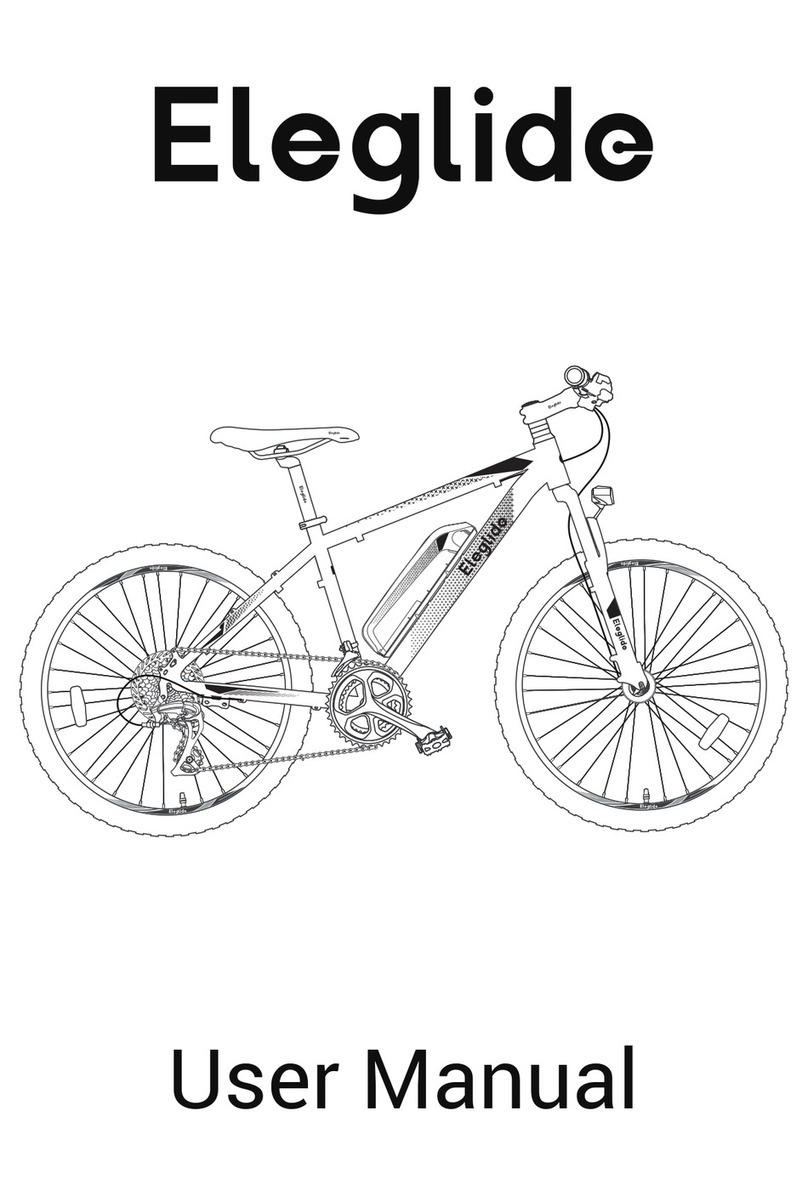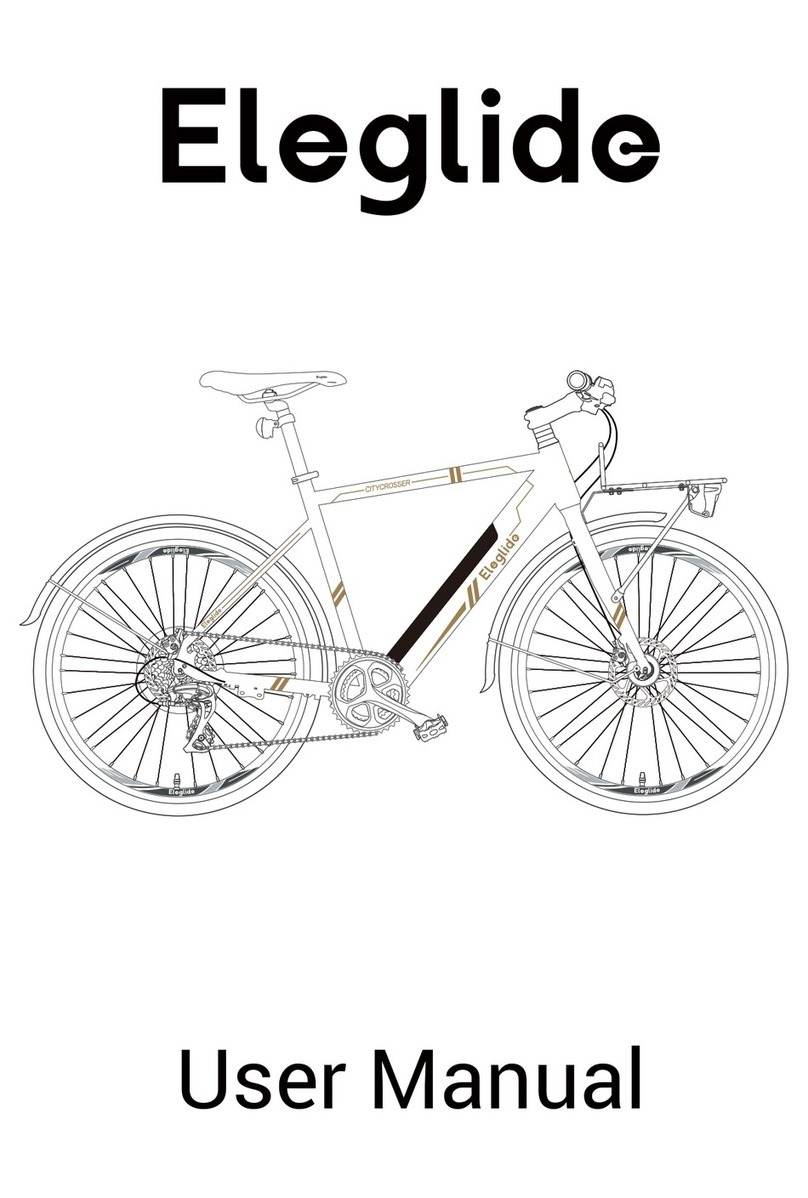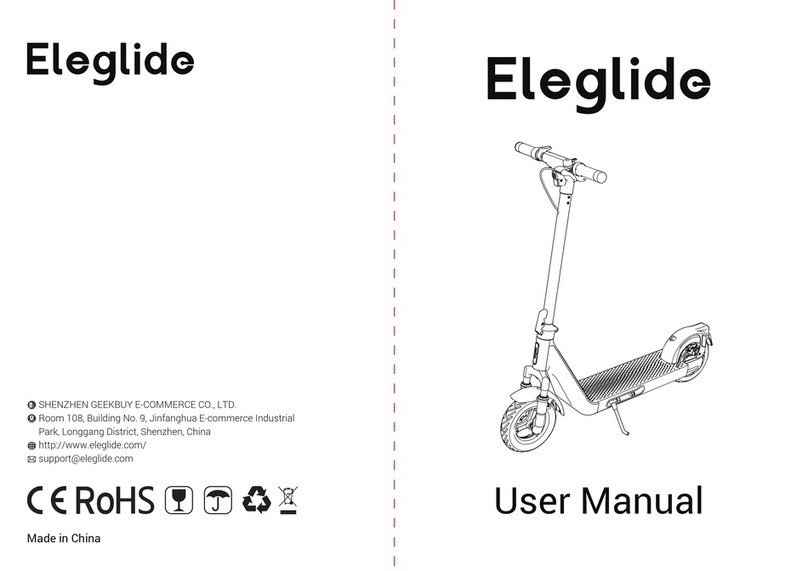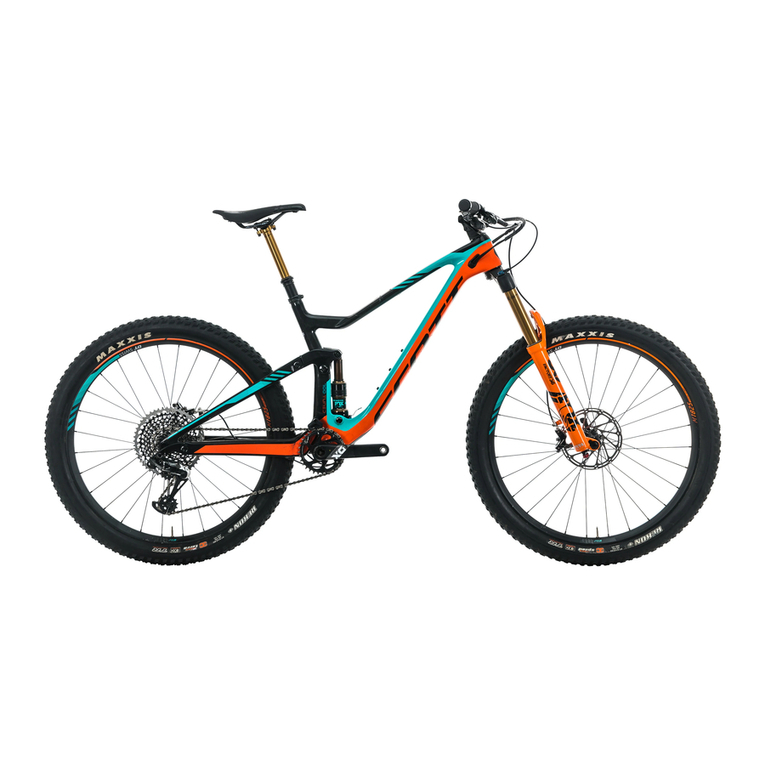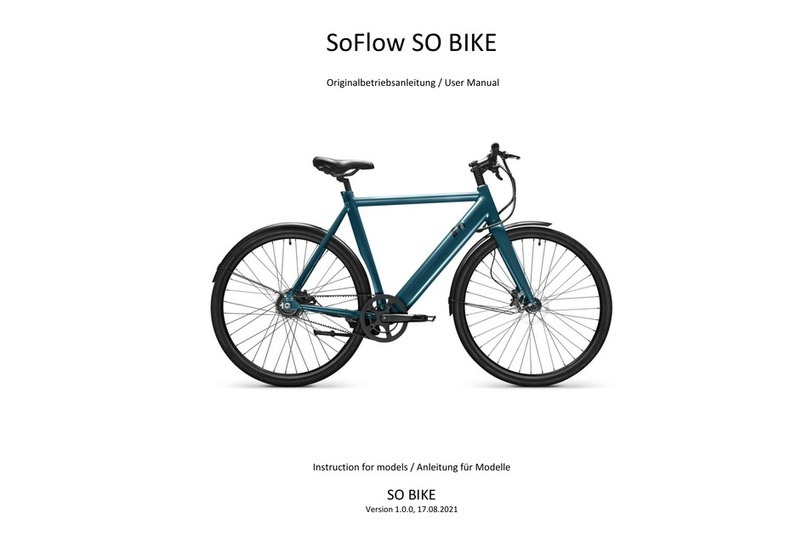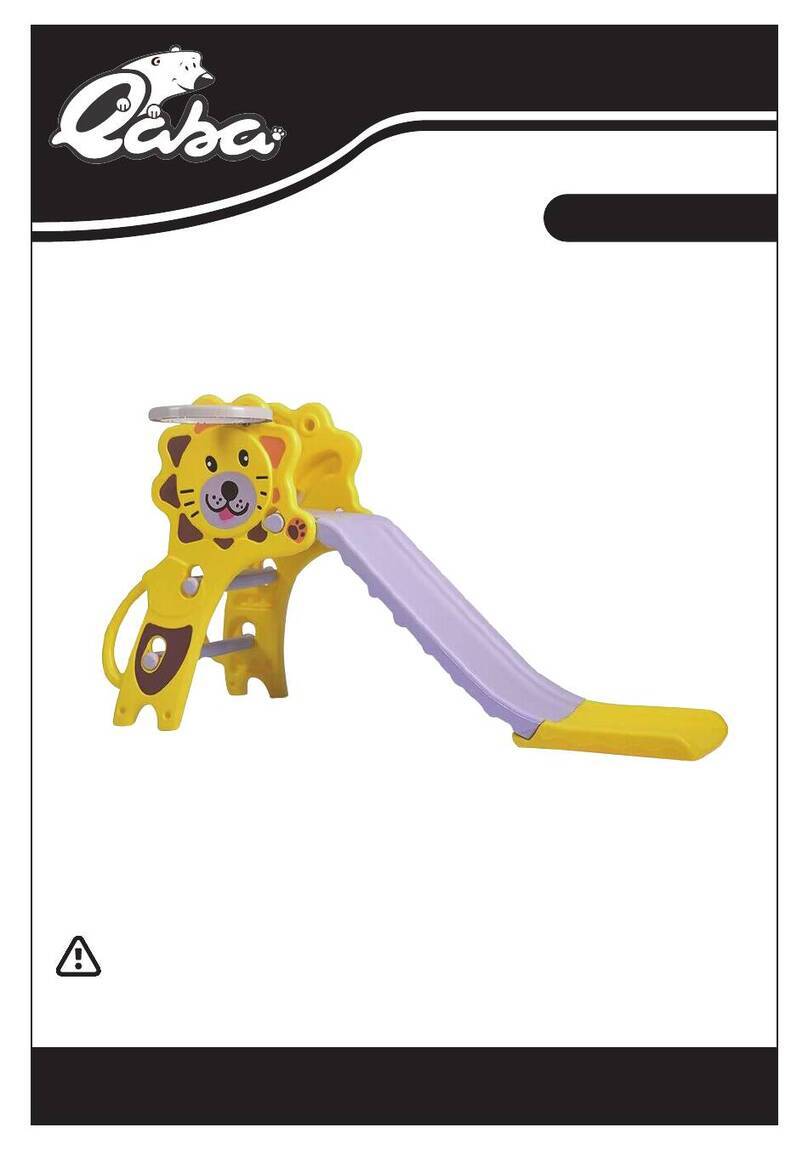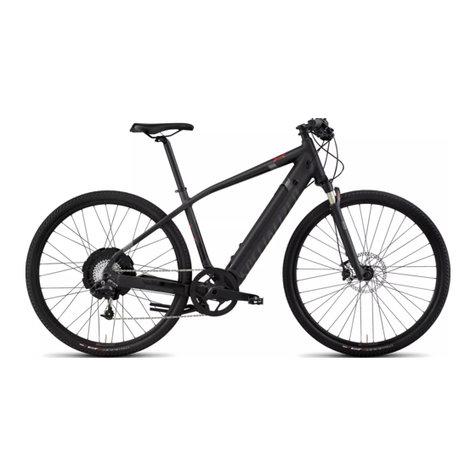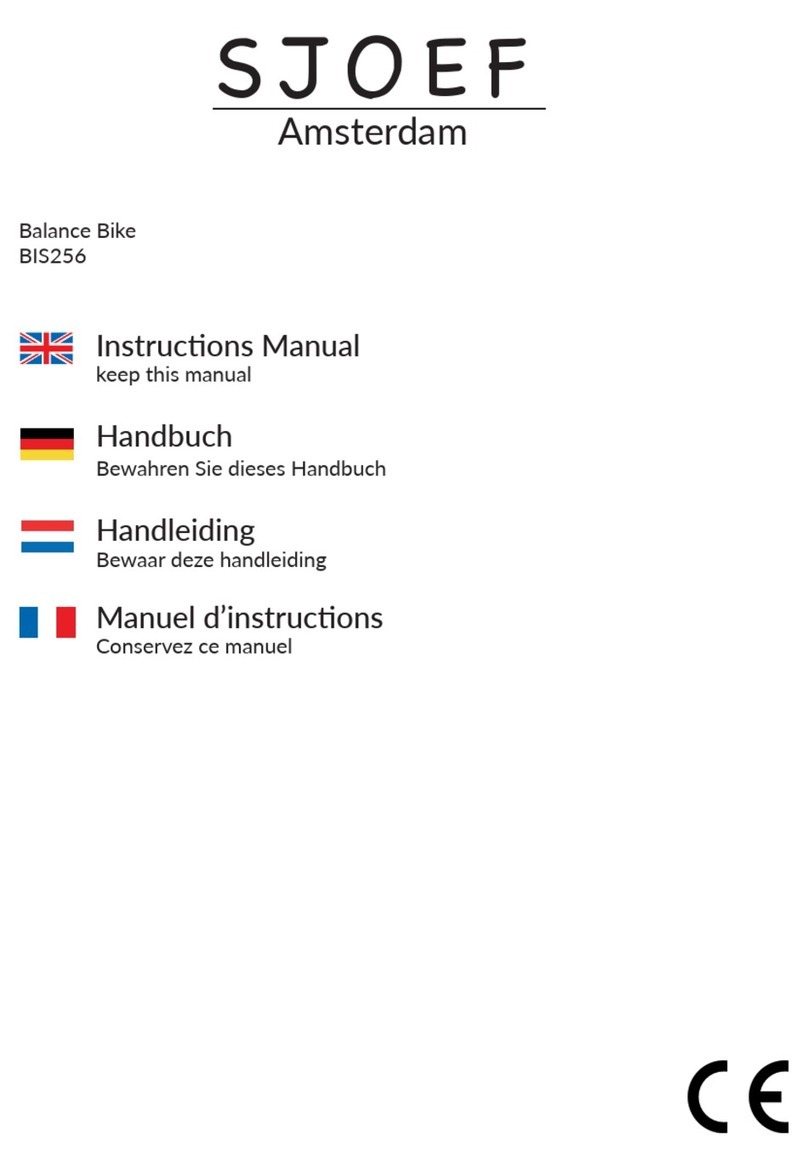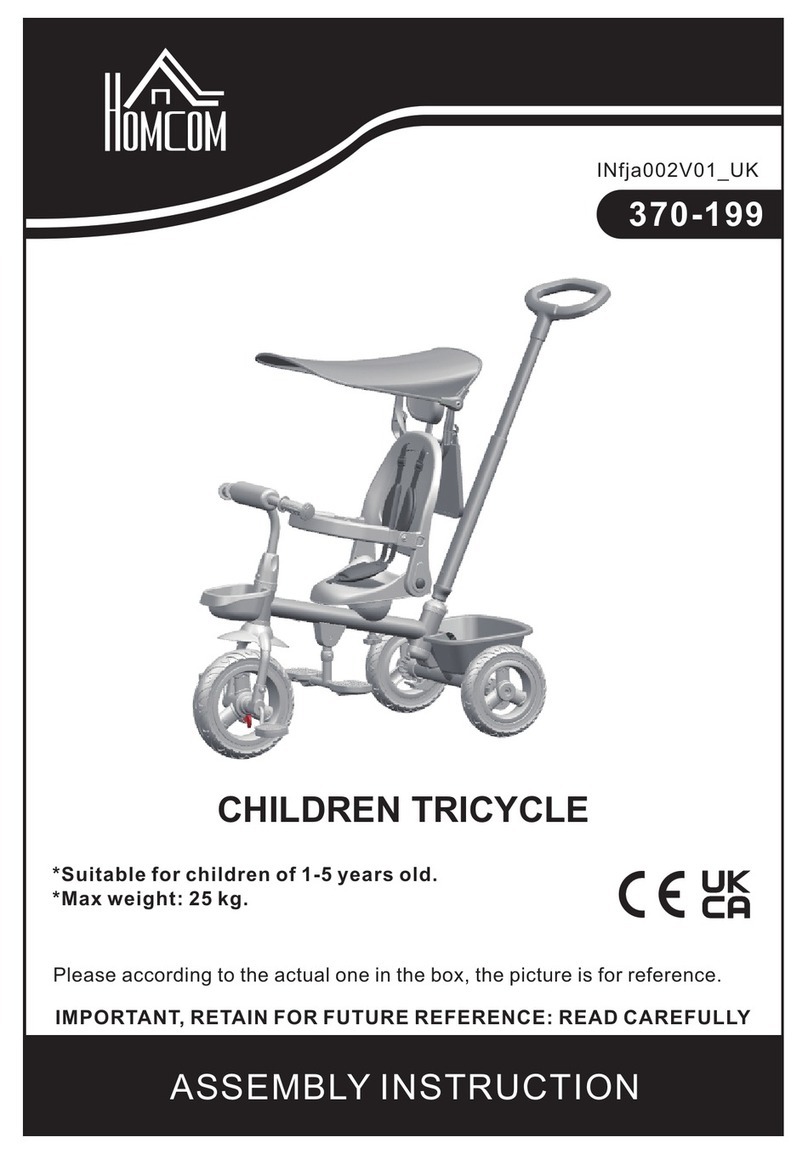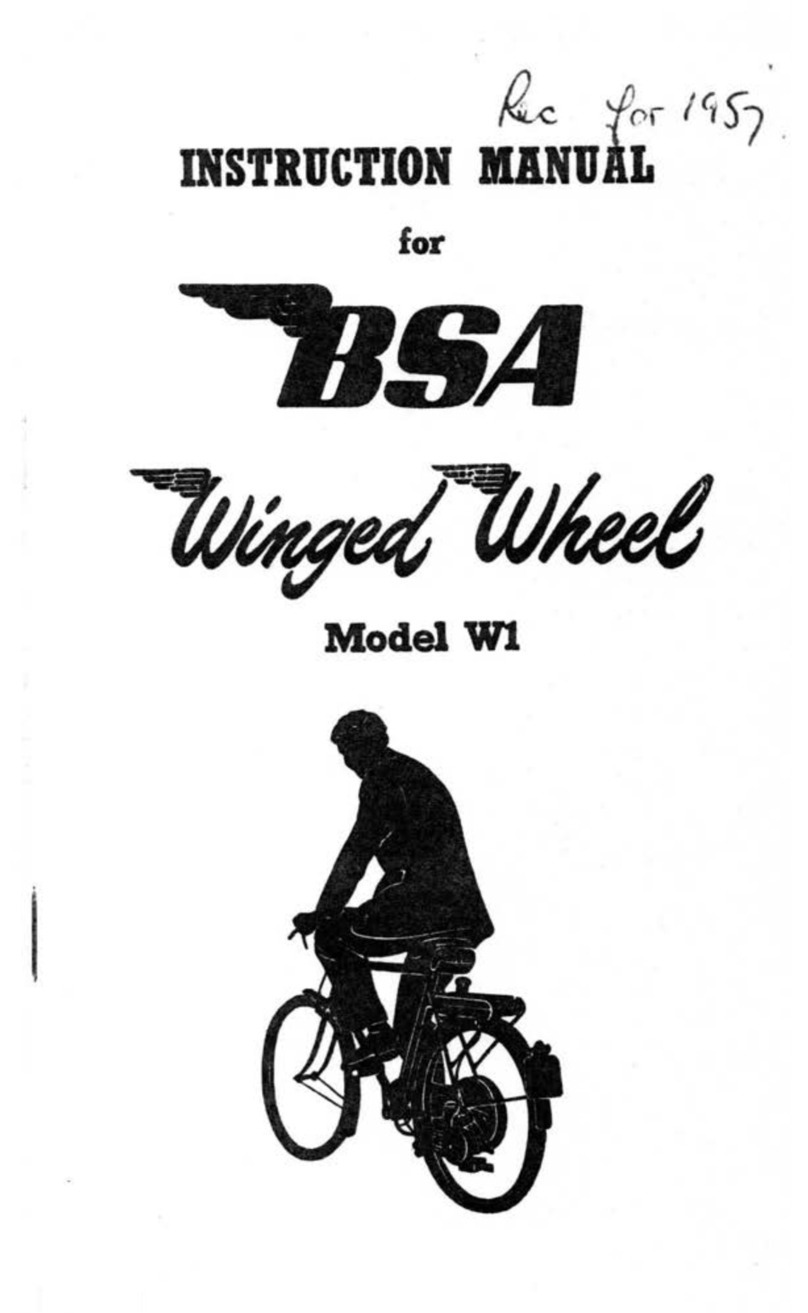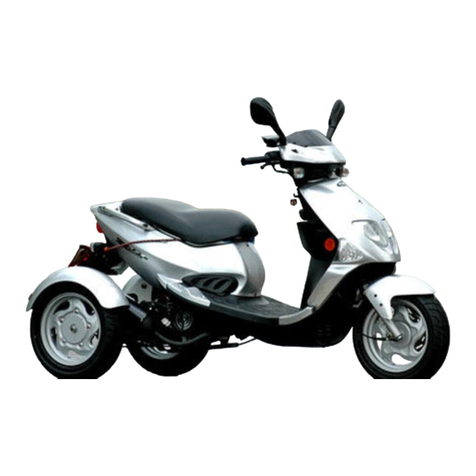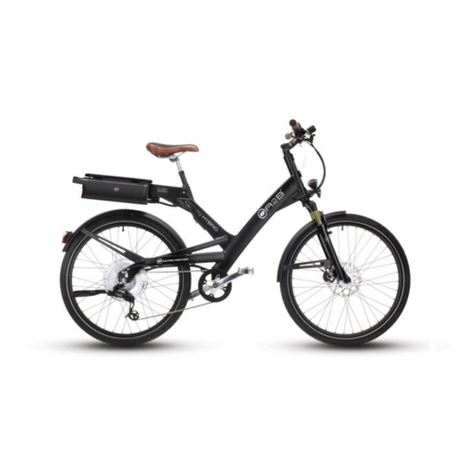Eleglide Tankroll User manual

User Manual

Pedelec and Pedal Assist
Apedelec(frompedalelectriccycle) orEPAC
(Electronically Power Assisted Cycles), is a type of
electric bicyclewhere the rider's pedalling isassisted
by anelectric motor.
Pedal assist isa mode on your moped bike that
provides power from the motor to help you pedal
more easily and move faster. When you turn on pedal
assist and choose your level of assist, the motor will
provide a certain level of power output as you pedal.
This may feel like a slight push as you ride.

CATALOGUE
1~15
16~30
31~45
46~60
61~75
76~90
ENGLISH
FRANÇAIS
DEUTSCHE
ESPAÑOL
ITALIANO
POLSKI

Before each charge, check the charger, cable and plug. If there is any damage, do not use the charger.
Before riding, check the tire pressure and check whether the wheels and handlebar are installed
correctly and tightly.
Before riding, check whether the headlights are securely fastened in the correct position, clean and not
covered by anything. Damaged reflectors must be replaced.
Besides, if the seat post in the seat tube is not inserted deep enough to reach the minimum insertion
2. Warning
*Before your first operation,
please read the user manual carefully!
1
EN
1.Note
2.Warning
3.Diagram
4.Specification
5.Package List
6.Assembly Guide
7.Display Guide
8.Maintenance
9.Troubleshooting
10.Warranty
11. Compliance Statements
Contents
Before your first ride, it is important for you to know your new pedelec well, so that you can get the best
performance, comfort, enjoyment and safety from it during your ride. To understand the new bicycle
and the correct operation, you should first read the manual carefully.
Second, it is significant to take your first ride under a safe and controlled circumstance, like staying
away from cars, obstacles and other cyclists.
Third, bicycles are vehicles with certain risks. Please follow the traffic rules during cycling. It’s better to
learn the local traffic rules about riding an pedelec on public roads before your first ride in case you
violate the regulations. For your own safety, never forget to put on a qualified helmet before you get on
the pedelec.
Fourth, the electric moped bike is supplied without basic mandatory equipment, which may vary from
place to place. Therefore, if you intend to use the pedelec on public roads, it's necessary to equip the
bike with the basic mandatory equipment, in accordance with the relevant laws and regulations.
In addition, this product is designed for your personal use. Do not use it for commercial or other
purposes.
Last, keep this manual safe for reference.
1. Note

mark, the seat post may break. Check whether it is inserted deeper than the minimum insertion depth.
When braking on a wet road, the braking distance is usually longer than on a dry road. Therefore, brake
earlier for a safer stop.
When you have to brake urgently, please hit the right hand brake first to stop the rear wheel, and then
hit the left hand brake, especially when you brake at a high speed. If the front wheel stops suddenly
while the rear wheel is still cycling at a high speed, you may fall over and get hurt. So please ride it
carefully. The handlebar may be affected as you steer or brake the bike.
Furthermore, avoid puddles, wet mud, swamps, water, snow or ice. Try not to use the pedelec on a
rainy, stormy or snowy day. If the bicycle’s electric parts (control unit, engine and battery) get damp,
wet or soaked, it will cause irreversible damage, or even a battery explosion.
This product can only be used by one adult at a time. Do not carry any extra passengers.
This vehicle is not a toy. Same as other vehicles, it is possible to fall, crash or encounter other danger-
ous situations. Please don’t offer your pedelec to anyone that doesn’t know how to use it correctly. If
you let anyone else ride your bike, it will be your responsibility to ensure that all riders understand all
warnings, cautions, instructions and safety precautions, and to ensure that they are able to use this
product safely and responsibly and protect themselves and others from injury.
Do not modify your bike. You'll be responsible for any issues caused by your personal modification.
3. Diagram
1. Handlebar with Display
4. Front Mudguard
7. Frame
10. Quick Release
13. Chain
16. Rear Wheel
19. Brake Caliper
2. Stem
5. Front Fork
8. Battery
11. Chainwheel
14. Rear Derailleur
17. Rear Mudguard
20. Motor
3. Front Light
6. Front Wheel
9. Saddle
12. Pedals
15. Flywheel
18. Rear Reflector
21. Brake Disc
2
EN

1. Brake Lever
4. Handle
2. Gear Shifter
5. Button of Display
3. Display
3
EN
A. 74.5"
B. 47"
C. 46"
D. 34"
E. 41"
F. 34.5"
G. 27"
H. 17"
I. 22.8"
A
C
B
D
E
F
G
I
H
26"

Model
Basic Spec.
Derailleur
Motor
Battery
Brake
Brake Disc
Tire
Display
Shock
Absorption
4. Specification
Tankroll
1890x660x1190mm
165-200cm
660mm
IPX4
Aluminium Alloy (AL6061)
120kg
70km
No Limit
25km/h
6 km/h
12/16/20/23/25 km/h (Level 1-5)
7 (Rear), Shimano
Shift Gears by Pushing the Thumb Shifter
48V
740W
285
57Nm
48V
10Ah / 480Wh
6.5h
Yes
Disc Brake & Auto Power-off Design
160mm
1.9mm
Brake front wheel by the left hand and rear
wheel by the right hand in the EU;
Brake front wheel by the right hand and
rear wheel by the left hand in the UK;
26"x4.0"
CST Pneumatic Rubber Tires with Steel
Wires
20-30PSI
22PSI (Front), 26PSI (Rear)
2.4" LCD
Hydraulic Suspension with a Lockout
Lock/Unlock the Suspension by Rotating
the Blue Knob on the Front Fork
Unfolded Size
Recommended Rider Heights
Length of Handlebar
Waterproof Level
Material of Frame
Max Load
Max. Range
Cut-off Speed
Push Mode
Speed Level of Assist Mode
Number of Gears, Brand
Control
Rated Voltage
Max. Inst. Power
Max. RPM
Max. Output Torque
Voltage
Capacity
Charging Time
Protection System
Type
Outside Diameter
Thickness
Control
Size
Type
Tire Pressure
Best Tire Pressure
Size, Type
Type
Control
Assist Mode
Manual Mode
Note: the max speed and range data are provided by the Eleglide lab. The max range is achieved under the
following conditions: a full charge, a 75kg load, 26 °C temperature, 15km/h constant speed, on flat roads with
no strong wind.
The actual data may vary based on different road conditions, temperature, humidity, wind speed, and the
rider’s habits (the frequency of braking, speed shifting, etc.) and rider’s weight.
4
EN

5. Package List
Eleglide Pedelec x 1
Charger x 1
Spoke Reflector x 2
Front Mudguard x 1
Key x 2
User Manual x 1
Power Cord x 1
Rear Reflector x 1
Rear Mudguard x 1
Tool Kit x 1
Pedal x 2
Front Light x 1
Display x 1
Saddle x 1
6. Assembly
Step 1 Install The Handlebar
A) Take out the bike and make it stand up.
B) Open the stem clamp by loosing the screws on it.
C) Place the handlebar in the right position and make sure the clamp is in the middle of the bar.
D) Close the clamp and secure the handlebar by tightening the screws.
5
EN
Step 2 Install The Front Wheel
A) Put the bike upside down.
B) Remove the temporary protected bar by loosening the nuts on it.
C) Loosen the nuts on the front wheel and insert the front wheel between the fork blades so that the
axle can seat firmly at the fork dropouts (the slots at the tip of the fork blades).
D) Tighten the nuts to secure the front wheel.

Step 3 Install The Front Light and Front Mudguard
A) Loosen the screws on the fork crown and take them out.
B) Place the front light and front mudguard in the right position.
C) Slide the screws through the front light, front mudguard and front fork, and then tighten them.
D) Secure the front mudguard. (There are 2 screws on the fork blades for securing the mudguard.)
E) Connect the light cable with the bike cable.
Step 4 Install The Display
A) Open the 2 support rings of the display by loosening the screws on them.
B) Put the support rings through the handlebar.
C) Close the rings to secure the display. (Make sure the display is in the middle of the handlebar.)
D) Open the clip of the display button and buckle it on the handlebar.
E) Connect one of the display cables with the bike cable and another display cable with the button cable.
(Connectors of the same color should be connected together.)
6
EN

Step 5 Install The Rear Reflector
Step 6 Install The Pedals
Pedal Left Right
7
EN

7. Display Guide
Contents on The Display
Light Mark
Speed Level
Trip Distance/Odometer
Speed/
Error Code
Push Mode
Brake/
Malfunction Mark
Battery Level
Battery Level Indicator
≤20% ≤40% ≤60% ≤80% ≤100%
Up
Down
On/off Button
Functions
Power on/off
Long press the for 3 seconds to turn the display on/off.
Light on/off
Short press the to turn the light on/off.
8
EN

P3: setting the screen
timeout within
0-30 minutes; 0
means it never sleeps.
P1: adjusting the
brightness of the
display backlight from
level 1 to 3;
P2: setting the speed
limit; The default
speed limit is 25km/h.
P4: setting the
default speed level;
0 means starting at
speed level 0, and 1
means starting at
speed level 1.
Shifting Speed Level
Short press or to shift among 5 speed levels, including 12/16/20/23/25 km/h.
6km/h Push Mode
When the bike is at zero speed, long press to activate the push mode.
Switching Trip Distance/Odometer
Short press the twice to switch trip distance with odometer.
Changing Speed Unit
Short press the 3 times to switch between “km” and “mile”.
Removing Odometer Data
When the display is on, long press the for 8 seconds till the display flashes. The odometer data
will be removed when the display reboots.
Hidden Menu
First, long press both and to enter the hidden menu. Second, short press to shift among
different menu pages. Different pages are for setting different functions. Third, after selecting the page
you want, short press or to set the item on the page. Fourth, after setting, long press both
and to exit the hidden menu.
9
EN

Solutions
a.Replace the motor;
b.Replace the motor adapter cable;
c.Replace the controller;
a.Re-connect the display and controller;
b.Replace the display;
c.Replace the controller;
Check the above solutions of E01 and E04.
a.Charge the battery;
b.Re-connect the battery and the controller;
c.Replace the controller;
d.Replace the display;
a.Re-connect the controller;
b.Replace the controller;
Check the above solutions of E01 and E10.
a.Replace the motor;
b.Replace the motor adapter cable;
c.Replace the controller;
Causes
The motor is out of phase.
Communication error;
Both E01 and E04 are occurring.
Under-voltage fault;
Controller fault;
Both E01 and E10 are occurring.
Motor hall signal abnormality;
Error Codes
E01
E04
E05
E08
E10
E11
E40
Error Tracking
10
EN

Cleaning
Use a soft and wet cloth to wipe the mainframe clean. Dirt that is hard to remove can be scrubbed with
a toothbrush and toothpaste, then cleaned with a soft and damp cloth. Do not wash your pedelec with
alcohol, gasoline, acetone, or other corrosive/volatile solvents. These substances may damage the
appearance and internal structure of the pedelec. Do not soak the bike or wash it with a pressure
washer or hose.
Storage
A)Bicycle
1. Do not expose the pedelec to direct sunlight or rain for an extended period of time, and avoid storing
it at a high temperature. It’s better to store the bike in a dry and safe place at a temperature of
0°C-25°C.
2.Avoid corrosive gas, so as to avoid chemical corrosion and damage to the electrical parts and
painted surfaces, which may lead to operational failure and accident.
3.Don’t store it in an explosive or flammable environment or near flammable liquids.
B)Lithium-ion Battery
1.Charge the battery after each ride and avoid draining the battery completely. Because completely
draining the battery may cause permanent damage to it. Never keep the lithium-ion battery
discharged for a long time. If the voltage of the cell drops under allowed limit due to self-discharge, it
will cause damage. For maximum durability, store the battery charged up to 50% of the maximum
capacity.
2.Never charge the battery in an explosive or flammable environment or near flammable liquids. Do not
charge the battery on a flammable substrate, such as paper, textiles, etc., when the battery is
detached from the vehicle. Charge it at a safe place away from flammable items.
3.Never charge a battery which is already damaged or is leaking.
4.Don’t charge the battery too long. Stop charging when it gets full.
5.Charge or discharge the battery at a temperature within 0~45°C.
6.It is better to store the battery indoors within 20°C~25°C temperature while it is not being used for a
long time. (When used at 25°C, the battery range and performance is at its best. But using it at a
temperature below 0°C can decrease its mileage and performance.)
7.Do not store the battery at a too high or too low temperature.
8.The humidity of the storage place should be 60±25%RH. As for the working place, the humidity
should be 5~85%RH.
9.Do not puncture, hit or crash the battery.
10.Don’t try to disassemble the old or damaged battery or throw it away. Please take it to the local
professional battery recycling facility.
8. Maintenance
11
EN

Head Sets
Joints
Brakes
Front Suspension Fork
Tires
Wheel Hubs
Pedals
Cranks
Chain
Rims
Sprockets
Saddle and Seat Post
Kickstand
Remove, clean and lubricate the rims annually. Replace them if
necessary.
Continuously check all nuts, bolts and quick-release devices for
tightness.
Lubricate the brake cables slightly with oil monthly. Check the
adjustment and replace the brake parts (blocks, shoes, pads) in time
if they are worn. The cables must be replaced if they are
damaged/down.
Entrust it to experts.
Regularly check for damage, wear, cut and air leakage.
Lubricate the hub bearings monthly. Check and adjust the cones, if
necessary, to prevent the hubs from rubbing against the forks.
Lubricate the bearings and check for tightness.
Lubricate the bearings monthly (unless a maintenance-free center
bracket is installed on the bike). Check whether all center bracket
parts are correctly tightened.
Take it off and clean it every 6 months. The chain must be clean but
not dry.
Frequently check whether the wheels are tight and secure. The rims
should be protected from oil, wax, grease, adhesive, etc. Check
whether the spokes are loosing or missing.
Clean regularly as necessary and grease lightly. Keep the front and
rear derailleur running smoothly by adjusting.
Check whether the screws, nuts and quick-release devices are tight.
Clean and lightly grease it annually.
C) Other Parts
12
EN
Attention: when lubricating, make sure the lubricant doesn't get on the brake discs and pads. Otherwise,
the brake system may fail to function.Driving with a bad wheel bearing can cause the axle/hub/spindle to
weld itself from friction and heat, causing the wheel to lock up and spin you out. More likely, the metal will
wear away from the friction and the wheel/hub will become loose. Replace worn/damaged parts in time,
such as inner and outer tires, brake kits, etc.

Please check the following issues and solutions before sending the product to designated repair
offices.
9. Troubleshooting
Problem
The display fails to work
or the vehicle can’t be
turned on.
The front light fails to
work.
The battery fails to
charge.
Insufficient Riding
Distance
Possible Causes
a. No power supply;
b. The electric wire is not plugged in
properly or tightly;
c. The display is damaged;
d. Controller burnout or water damage;
a. The wire isn’t plugged in properly;
b. It is damaged;
a. The charger isn’t plugged in properly;
b. It is out of the recommended
temperature range;
c. The battery is charged below rated
voltage;
d. It is damaged;
a. Battery isn’t fully charged;
b. Low tire pressure;
c. Frequent braking;
d. Battery aging or battery capacity
attenuation;
e. Low ambient temperature;
Solutions
a. Charge the battery;
b. Reconnect the electric wire
properly and tightly;
c.& d. Contact the re-seller for
help;
a. Plug the wire in properly;
b. Contact the re-seller;
a. Plug it in properly and charge it
again;
b. Charge it at a proper tempera
ture;
c. Charge it under rated voltage;
d. Contact the re-seller;
a. Fully charge the battery;
b. Check the tire pressure before
each use;
c. Develop good riding habits;
d.& e. It’s normal;
Attention: if any other failures occur and you can not find any solution from the chart above, please
contact the re-seller to solve it. Any other maintenance and repair that need to be done by using professional
tools and techniques, should be performed by a qualified bicycle mechanic designated by manufacturer or
the maintenance center.
13
EN

Eleglide provides an easy, reliable and efficient service for all products under our warranty. Please refer
to the chart below for the warranty periods of various products and accessories starting from the date
of purchase.
Our distributors, partners, sellers and re-sellers should provide after-sale services directly to their
customers. If your Eleglide product has a warranty-related issue, please contact the seller from whom
you purchased the product. You should provide all relevant order information, such as order numbers,
invoices, receipts, etc.
10. Warranty
Model
Tankroll
Components
Frame
Front Fork
Controller
Motor
Charger
Battery
Display
Chainwheel
Freewheel
Brake Assembly
Thumb Shifter
Rear Derailleur
Kickstand
Front Light
Pedal
Others
Warranty
3 years
1 year
1 year
1 year
1 year
6 months
6 months
6 months
6 months
6 months
6 months
6 months
3 months
6 months
3 months
14 days
Warranty Process
Buyers have to provide sufficient proof of purchase.
A description of the defect needs to be provided in order to issue a warranty claim.
Visible proof of defect must be provided along with the item's serial number (if any).
Eleglide must document what happens when buyers troubleshoot the products.
You may need to return an item for quality inspection.
When you return the defective product, you should put it in the original packaging or the packaging
approved by the dealer.
14
EN

Warranty will be void in the following situations:
The product is out of the warranty period.
The product is lost or stolen.
The product is free or complimentary.
The product is used in inappropriate ways or conditions, including but not limited to: falls, extreme
temperatures, water, improper operations.
The product is not in its original state, such as modifications.
The product has been used in combinations with accessories that is not compatible with the product.
Buyers have no sufficient proof of purchase of products.
Unsupported software or firmware has been installed to the product.
When damage is caused by the customer, the customer is responsible for the costs for the repairs and
shipment.
Customers' personal items are sent to Eleglide, instead of the Eleglide products.
Note: more than one type of proof of purchase may be required to process a warranty claim (such as receipt
of money transfer and confirmation of address that the item was originally shipped to).
Valid Proof of Purchase
The order number of your online purchase from the Eleglide's authorized reseller;
Sales invoice;
Dated sales receipt from the authorized Eleglide's reseller;
15
EN
This product complies with the EN15194 standards of the European
Community.
This product complies with the Restriction of Hazardous Substances in
Electrical and Electronic Equipment (RoHS) EU rules restricting the use of
hazardous substances in electrical and electronic equipment to protect the
environment and public health.
This product is in compliance with the applicable requirements for
products sold within Great Britain.
This symbol indicates that the product is capable of being recycled.
This symbol indicates that the product should not be disposed of as
household waste. The product must be sent to separate collection facilities
for recovery and recycling of electrical and electronic equipment.
This symbol indicates that the product inside the packaging could be easily
damaged if dropped or handled without care and attention. The contents
are fragile !
This symbol indicates that the product should be kept away from rain and
in dry conditions.
The warning sign indicates a potential hazard, danger, obstacle, or
condition requiring special attention.
11. Compliance Statements

*Avant votre première utilisation,
veuillez lire attentivement le manuel utilisateur !
16
FR
1. Note
2. Avertissement
3. Schéma
4. Spécification
5. Liste des éléments fournis
6. Guide de montage
7. Guide de l'écran
8. Entretien
9. Dépannage
10. Garantie
11. Déclarations de conformité
Contenu
Avant votre première sortie, il est important que vous connaissiez bien votre nouveau pedelec, afin d'en
tirer les meilleures performances, le meilleur confort, le plus grand plaisir et la plus grande sécurité lors
de vos sorties. Pour comprendre le nouveau vélo et son fonctionnement adéquat, vous devez d'abord lire
attentivement le manuel.
Deuxièmement, il est important de faire votre première sortie dans des conditions sûres et contrôlées,
par exemple en restant à l'écart des voitures, des obstacles et des autres cyclistes.
Troisièmement, les bicyclettes sont des véhicules présentant certains risques. Veuillez respecter le code
de la route lorsque vous faites du vélo. Il est préférable d'apprendre les règles de circulation locales
concernant la conduite d'une bicyclette électrique sur les voies publiques avant votre première sortie, au
cas où vous enfreindriez les règles. Pour votre propre sécurité, n'oubliez jamais de mettre un casque
approprié avant de monter sur le pedelec.
Quatrièmement, le pedelec est fourni sans équipement obligatoire de base, qui peut varier d'un endroit à
l'autre. Par conséquent, si vous avez l'intention d'utiliser le pedelec sur les routes publiques, il est
nécessaire d'équiper le vélo du matériel obligatoire de base, conformément aux lois et règlements en
vigueur.
En outre, ce produit est conçu pour votre usage personnel. Ne l'utilisez pas à des fins commerciales ou
autres.
Enfin, conservez ce manuel pour pouvoir vous y référer.
1. Note
Avant chaque recharge, vérifiez le chargeur, le câble et la prise. S'ils sont endommagés, n'utilisez pas le
chargeur. Avant de rouler, vérifiez la pression des pneus et vérifiez si les roues et le guidon sont
installés correctement et fermement.
Avant de rouler, vérifiez si les phares sont bien fixés dans la bonne position, s'ils sont propres et s'ils ne
sont pas couverts par quelque chose. Les réflecteurs endommagés doivent être remplacés.
En outre, si le support de selle dans le tube de selle n'est pas inséré assez profondément pour atteindre
le repère d'insertion minimum, la tige de selle peut se casser. Vérifiez si elle est insérée plus profondé-
ment que la profondeur d'insertion minimale.
Lorsque vous freinez sur une route mouillée, la distance de freinage est généralement plus longue que
2. Avertissement

17
FR
3.Schéma
1. Guidon avec écran
4. Garde-boue avant
7. Cadre
10. Mécanisme liberation rapide
13. Chaîne
16. Roue arrière
19. Étrier de frein
2. Potence
5. Fourche avant
8. Batterie
11. Plateau de chaîne
14. Dérailleur arrière
17. Garde-boue arrière
20. Moteur
3. Phare avant
6. Roue avant
9. Selle
12. Pédales
15. Roue d'inertie
18. Réflecteur arrière
21. Disque de frein
sur une route sèche. Par conséquent, freinez plus tôt pour un arrêt plus sûr.
Lorsque vous devez freiner d'urgence, serrez d'abord le frein à main droit pour arrêter la roue arrière,
puis serrez le frein à main gauche, surtout lorsque vous freinez à grande vitesse. Si la roue avant
s'arrête soudainement alors que la roue arrière roule toujours à grande vitesse, vous risquez de tomber
et de vous blesser. Veuillez donc rouler prudemment. Le guidon peut être affecté lorsque l'utilisateur
dirige ou freine le vélo.
En outre, évitez les flaques d'eau, la boue humide, les marécages, l'eau, la neige ou la glace. Essayez de
ne pas utiliser le pedelec par temps de pluie, de tempête ou de neige. Si les parties électriques du vélo
(unité de commande, moteur et batterie) sont humides, mouillées ou trempées, cela provoquera des
dommages irréversibles, voire une explosion de la batterie.
Ce produit ne peut être utilisé que par un seul adulte à la fois. Ne transportez pas de passagers
supplémentaires.
Ce véhicule n'est pas un jouet. Comme tout autre véhicule, il est possible de tomber, de s'écraser ou de
rencontrer d'autres situations dangereuses.
N'offrez pas votre pedelec à une personne qui ne sait pas comment l'utiliser correctement. Si vous
laissez quelqu'un d'autre utiliser votre vélo, il vous incombera de veiller à ce que tous les utilisateurs
comprennent tous les avertissements, mises en garde, instructions et mesures de sécurité, et de vous
assurer qu'ils sont en mesure d'utiliser ce produit de manière sûre et responsable et de se protéger
eux-mêmes et les autres contre les blessures.
Ne modifiez pas votre vélo. Vous serez responsable de tout problème causé par votre modification
personnelle.
Table of contents
Languages:
Other Eleglide Bicycle manuals
